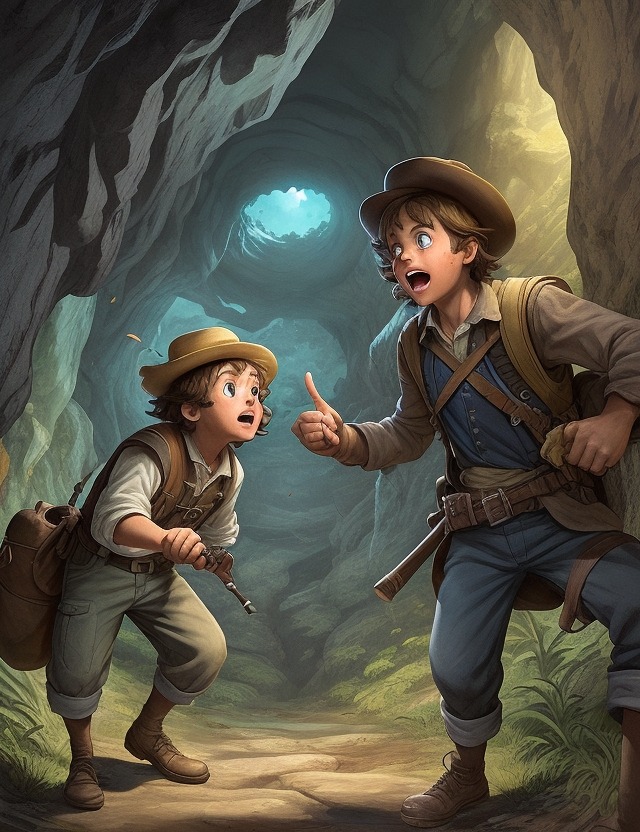In the realm of American literary classics, Mark Twain’s masterpiece, “The Adventures of Huckleberry Finn,” stands tall as a captivating adventure narrative that transcends time. Delving into this monumental work, we unlock a treasure trove of adventure, social commentary, and an exploration of the human spirit against the backdrop of the turbulent 19th-century South. Brace yourself for a gripping voyage down the Mississippi River, as we unravel the enigmatic journey of Huck Finn, our audacious young protagonist, and his unlikely companion, the runaway slave Jim.
Join us as we navigate the deep waters of this renowned novel, peeling back its layers to reveal the profound social critiques, controversial themes, and enduring lessons concealed within. By dissecting Twain’s brilliantly crafted characters and their vivid escapades, we unravel the tapestry of an era long gone, shedding light on the complexities of race, morality, and societal norms that continue to resonate even in the modern day.
The Adventures of Huckleberry Finn: Full Book Short Summary
Once upon a time, there was a young boy named Huckleberry Finn who lived in the small town of St. Petersburg in Missouri. Huckleberry, or Huck as everyone called him, was adventurous and always seeking excitement. He lived with the Widow Douglas and her strict sister, Miss Watson, who tried their best to civilize him and teach him good manners.
Now Huck, he had a free spirit and couldn’t stand all the rules and restrictions that were forced upon him. He longed for the freedom of the great outdoors, away from school and chores. So, one day, he decided to run away from St. Petersburg, believing that life on his own would be much better.
As he set out on his journey, Huck’s path crossed with another runaway, Tom Sawyer. Tom was a mischievous and imaginative boy who lived in St. Petersburg and was known for getting into all sorts of adventures. He recognized Huck’s plan and convinced him to join him on an even more exciting adventure.
Together, they set off down the Mississippi River on a raft, encountering all sorts of interesting people and situations along the way. The first person they meet is Jim, Miss Watson’s slave, who had also decided to escape as he heard that he might be sold to another slave owner. Jim tells them that he is heading towards the free states, where he can be a free man. Huck and Tom agree to help him, and together they become a team, with Jim becoming a dear friend to Huck.
The trio faces many challenges during their journey. They come across a group of thieves who mistake Huck and Tom for somebody else and try to capture them. But the clever boys manage to escape and continue their journey.
One day, while exploring a small town, Huck disguises himself as a girl to gather information. He discovers that someone in town is planning to capture Jim and return him to Miss Watson. Huck realizes that he cares deeply for Jim and cannot let him be taken away. He rushes back and warns Jim, and together they quickly flee on their raft.
As they continue downriver, Huck and Jim come across a grand-looking house floating on the river. They board it and meet two con artists, calling themselves the “Duke” and the “King.” These two manipulative men trick Huck and Jim into thinking that they are royalty and deserve respect. Huck sees through their lies but has no choice but to go along with them to keep himself and Jim safe.
Huck becomes increasingly uneasy with the Duke and the King’s schemes, especially when they attempt to deceive a family out of their inheritance. He starts to question his own morals and struggles with the decision of whether to continue with them or do what he knows is right. In the end, he couldn’t bear the guilt and decides to help the family and expose the true nature of the Duke and the King.
Huck’s moral growth continues when he faces another dilemma when they reach a town where Jim’s runaway status is known. Huck meets Tom’s Aunt Sally and pretends to be Tom, who is due to visit. Aunt Sally talks about capturing runaway slaves, and Huck is torn between revealing Jim’s true identity or keeping it a secret to protect his friend.
In the final dramatic climax of the story, Tom Sawyer arrives with his extravagant plans to rescue Jim. Huck is shocked and tries, unsuccessfully, to convince Tom that they can simply set Jim free, as Miss Watson has passed away and freed him in her will. Tom insists on making it a grand adventure, complete with secret tunnels, hidden messages, and all sorts of unnecessary complications.
But in the end, Huck’s practicality and sense of right prevail. A series of events leads to Jim’s recapture, and Huck decides to risk everything to help him escape. He writes a letter to Miss Watson, confessing his own “wicked” actions of helping a slave escape and declares that he is willing to go to hell for it. Against the societal expectations and norms he grew up with, Huck gathers the courage to stand up for his friend, risking punishment for doing what he believes is right.
In the end, Huck reaches a turning point in his journey. He sees the flaws in the society he was part of, the injustice towards slaves like Jim. Together, Huck and Jim continue their journey to find freedom and true happiness.
“The Adventures of Huckleberry Finn” is not just a thrilling and exciting tale of daring escapades, but it’s also a story that challenges us to question the world around us, to challenge the norms and prejudices within society, and to have the courage to stand up for what we believe is right, even if it means going against the expectations of others. It reminds us that true freedom and happiness can only be found when we follow our hearts and treat others with kindness and respect, irrespective of their race or social standing.
The Adventures of Huckleberry Finn Themes
The Adventures of Huckleberry Finn by Mark Twain is a classic American novel that tells the story of a young boy named Huck Finn who embarks on numerous adventures along the Mississippi River. The book explores several important themes that continue to resonate with readers and provoke discussion. The three key themes in The Adventures of Huckleberry Finn are:
- Racism and Slavery: One of the central themes of the novel is the examination of racism and the injustice of slavery in America during the mid-19th century. Through the character of Jim, a runaway slave who becomes Huck’s friend, Twain exposes the hypocrisy of a society that claims to value freedom but still perpetuates slavery. Huck grapples with his own beliefs and societal norms concerning race, eventually realizing the humanity of Jim despite the prevailing prejudices. Twain’s portrayal of Jim as a compassionate, intelligent, and caring individual challenges the prevalent stereotypes of African Americans at the time.
- Freedom and Independence: Another key theme explored in the book is the yearning for personal freedom and independence. Both Huck and Jim seek to escape the societal constraints that limit their freedom and hold them back. Huck is tired of being “sivilized” and longs for a life free from the rules and expectations imposed upon him. Jim longs to escape slavery and be reunited with his family. The novel emphasizes the importance of individual agency and the pursuit of one’s own path, even if it means going against the grain of society.
- Morality and Conscience: Twain delves into the nature of morality and conscience throughout the book. Huck struggles to reconcile the societal norms and religious teachings he has been exposed to with his own instincts and sense of compassion. This internal struggle is depicted when Huck wrestles with his decision to help Jim escape slavery, a choice that society would consider morally wrong. Twain questions the validity of external moral codes and encourages readers to listen to their own conscience rather than blindly following societal expectations.
Overall, The Adventures of Huckleberry Fin is a thought-provoking novel that tackles themes such as racism, freedom, and morality. Twain uses his storytelling prowess to shed light on the injustices of the time while challenging readers to question their own beliefs and values.
The Adventures of Huckleberry Finn Character Analysis
- Huckleberry Finn: The brave and mischievous protagonist of the story, Huckleberry Finn is a young, free-spirited boy who lives in a small town. With his shaggy blond hair and twinkling blue eyes, Huck sports a perpetual mischievous grin that reflects his adventurous nature. He is known for his resourcefulness and ability to navigate any situation that comes his way. Huck’s adventurous spirit leads him on various exploits, from escaping an abusive father to embarking on a thrilling journey down the Mississippi River with his friend Jim, a runaway slave. Despite his rough exterior, Huck possesses a heart of gold and is fiercely loyal to those he cares for. Watch out for his impressive ability to concoct elaborate schemes that leave others in awe and disbelief.
- Jim: A kind-hearted and intelligent runaway slave, Jim plays a vital role in Huck’s adventures. With a tall and sturdy frame, Jim’s presence commands respect. His deep brown eyes tell the story of years accumulated with wisdom and strength. Jim’s gentle nature and strong moral compass shine throughout the story, as he guides Huck both physically and emotionally through their perilous journey. Despite facing the harsh realities of slavery and the constant threat of capture, he maintains hope and resilience. Jim’s storytelling skills will transport you to a world of magic and wonder, revealing his extraordinary ability to find joy even in the direst of circumstances.
- Tom Sawyer: Huck’s mischievous and imaginative best friend, Tom Sawyer adds a touch of spontaneity and whimsy to the story. Tom’s sandy-haired and freckled face is always hidden beneath a wide-brimmed hat that he wears slightly askew to reflect his carefree attitude. With a devilish twinkle in his eyes, Tom emanates a contagious sense of fun, often dragging Huck into elaborate and sometimes overly complicated schemes. Tom’s fascination with treasure hunting and adventure leads him to concoct outlandish plans, which both astound and baffle others. Beware of his unwavering belief in romanticized the escapades, which often defy all logic but make for an entertaining read.
- Widow Douglas: The generous and kind-hearted guardian of Huck, Widow Douglas is a matronly figure in the story. With her graying hair and warm, inviting smile, Widow Douglas exudes a sense of wisdom and compassion. She takes Huck under her wing, providing him a safe haven and a sense of stability in his often turbulent life. Her calm demeanor and gentle guidance provide a stark contrast to the chaotic adventures that Huck encounters. Widow Douglas’s ability to see the inherent goodness in others serves as an inspiration throughout the story, reminding us of the power of acceptance and understanding.
- Pap Finn: The villainous and despicable character in the story, Pap Finn is Huck’s abusive and alcoholic father. Pap’s unkempt appearance mirrors his unruly nature, with greasy, matted hair and a scruffy beard covering his weathered face. His bloodshot eyes and coarse voice strike fear into the hearts of those around him. Despite his brash demeanor and volatile temperament, Pap serves as a harsh reminder of the societal injustices faced by many during that era. His presence lingers throughout the story as a persistent reminder of the challenges Huck must overcome in his journey towards freedom.
- The Duke and the King: In one of the most entertaining subplots of the story, the Duke and the King are a pair of cunning and deceitful con artists. The Duke, with his slicked-back black hair and sly smile, exudes a distinct air of charm and charisma. His partner, the King, dons a majestic, yet threadbare, regal attire, complete with a fake crown perched upon his head. Together, they weave a web of deception and chaos, employing various schemes to swindle unsuspecting victims. Their audacious antics and hilarious attempts at acting heighten the story’s comedic moments, providing a much-needed respite from the otherwise intense journey of Huck and Jim.
The Adventures of Huckleberry Finn: Symbols
1) The Mississippi River: The Mississippi River serves as a prominent symbol throughout the novel. It represents freedom, adventure, and escape from societal constraints. For Huck and Jim, the river is their refuge, providing them with a sense of independence and the opportunity to chart their own course. It also serves as a geographical marker, dividing the free states from the slave states, highlighting the issue of slavery and the moral dilemma faced by Huck as he decides whether to help Jim gain his freedom.
2) The raft: The raft, on which Huck and Jim travel down the Mississippi, symbolizes their journey towards liberation and self-discovery. It is a small, simple, and makeshift vessel, emphasizing the simplicity and purity of their desires. The raft becomes a sanctuary for Huck and Jim, shielding them from the evils of society and offering them a chance to develop a genuine bond and understanding. Moreover, the raft represents the constant movement and fluidity of life, as the characters navigate the ever-changing river and confront various challenges.
3) The Widow Douglas’ house: The Widow Douglas’ house represents society’s attempt to civilize and conform individuals to its norms. It is a place of rules, restrictions, and formal education. For Huck, the house symbolizes the constrictions and restraints of civilized life, highlighting his desire for freedom and autonomy. Furthermore, the contrast between the natural world and the artificiality of the house serves to emphasize the dichotomy between societal expectations and personal autonomy, a theme that runs throughout the novel.
Huckleberry Finn Setting
“The Adventures of Huckleberry Finn” by Mark Twain is primarily set in the pre-Civil War South along the Mississippi River. The novel begins in St. Petersburg, Missouri, which is based on Twain’s hometown of Hannibal, Missouri. Hannibal served as the inspiration for the fictional St. Petersburg, and the Mississippi River plays a crucial role in the story.
As the narrative progresses, much of the action takes place on a raft floating down the Mississippi River. The river serves as a symbol of freedom for the characters, especially for Jim, a runaway slave, and Huck, who seeks to escape from the constraints of society. The journey down the river is a central element of the novel, and the changing landscapes along the way contribute to the story’s episodic nature.
The novel also explores various towns and plantations along the riverbanks, offering a vivid portrayal of the Southern society of the time. The setting of “Huckleberry Finn” plays a significant role in shaping the themes of the story, particularly those related to freedom, morality, and the societal issues prevalent in the 19th-century United States.
The Adventures of Huckleberry Finn: Culture Impact
Tom Sawyer and Huckleberry Finn
The Adventures of Huckleberry Finn, written by Mark Twain and published in 1884, has left an indelible mark on American culture. It stirred controversies, sparked important discussions, and brought laughter and joy to countless readers. Let us delve into the historical data, funny anecdotes, and notable achievements of this remarkable literary work.
From a historical perspective, The Adventures of Huckleberry Finn played a significant role in exposing the realities of race relations and the injustices of slavery in pre-Civil War America. Twain’s depiction of Huck, a white protagonist developing a friendship with Jim, a black runaway slave, challenged prevailing racist attitudes of the time. This confrontational theme made the book a lightning rod for heated discussions on racial equality.
Despite its serious subject matter, the book’s humorous undertones added to its cultural impact. Twain’s witty writing style and Huck’s mischievous adventures brought levity to otherwise weighty themes. The misadventures of the main characters, such as the comical feud between the Grangerfords and the Shepherdsons, amplified the book’s entertainment value and endeared it to readers of all ages.
One notable achievement of The Adventures of Huckleberry Finn was its groundbreaking use of regional dialect. Twain intricately captured the unique speech patterns and slang of the Southern United States, making the text authentically relatable. This linguistic innovation contributed not only to the book’s artistic merit but also to its cultural significance. By valuing and preserving regional dialects, Twain celebrated the diversity of American language and affirmed their cultural relevance.
Moreover, The Adventures of Huckleberry Finn has had a lasting impact on American literature and has become a timeless classic. Its influence is evident in subsequent works of fiction that address social injustices and challenge societal norms head-on. The book’s moral and ethical messages continue to resonate with readers, inspiring a quest for freedom, empathy, and a fight against injustice.
It is crucial to acknowledge the controversies surrounding The Adventures of Huckleberry Finn as well. Some critics have argued that the book perpetuates stereotypes and racial tropes, while others have found it offensive due to its use of racial slurs, which were commonly used during the time it portrays. These controversies have fueled ongoing debates about how literature should grapple with uncomfortable aspects of history, and how it should be taught and understood in educational settings.
Overall, The Adventures of Huckleberry Finn has left an undeniable cultural impact. It shed light on the injustices of slavery, used humor to entertain and provoke thought, and showcased linguistic innovation through regional dialect. It continues to contribute to ongoing discussions about the complex issues of race and morality in American society. This book is not just a literary masterpiece, but a catalyst for social change, highlighting the power of literature to shape cultural consciousness.
FAQs
1. When was The Adventures of Huckleberry Finn written?
The Adventures of Huckleberry Finn was written by its author Mark Twain and published in 1884.
2. Can I read The Adventures of Huckleberry Finn if I haven’t read The Adventures of Tom Sawyer?
While The Adventures of Huckleberry Finn is a sequel to The Adventures of Tom Sawyer, it can be read as a standalone novel. However, reading Tom Sawyer beforehand may provide some additional insights and context.
3. Is The Adventures of Huckleberry Finn suitable for children?
The Adventures of Huckleberry Finn is often considered more appropriate for teenagers and adults due to its mature themes and racial language. Parents are encouraged to review the content beforehand and decide whether it’s appropriate for their children.
4. What are some of the main themes in The Adventures of Huckleberry Finn?
Some of the main themes explored in The Adventures of Huckleberry Finn include the hypocrisy and injustice of society, the conflict between civilization and freedom, the moral growth and development of the protagonist, and the exploration of race and racism in 19th-century America.
5. Why has The Adventures of Huckleberry Finn been considered controversial?
The novel has faced controversy mainly due to its use of racial slurs and its depiction of African American characters. Some argue that it perpetuates racial stereotypes, while others view it as a critique of societal prejudices. The book’s complex portrayal of race and social issues has led to ongoing debates about its place in the literary canon and in educational curriculums.
6. Why Huckleberry Finn should be taught in schools?
One of the main reasons why “The Adventures of Huckleberry Finn” should be taught in schools is that it provides students with a unique perspective on American history and culture. The book offers a glimpse into the lives of people who lived during a time of great social and political change in America. It also explores important themes such as slavery, racism, and the struggle for freedom and equality.
Another reason why the book is often included in school curriculums is that it is a powerful work of literature that can help students develop critical thinking skills. The novel challenges readers to think deeply about important issues such as morality, justice, and the nature of freedom. It also encourages readers to question their own beliefs and values, and to consider the perspectives of others.










